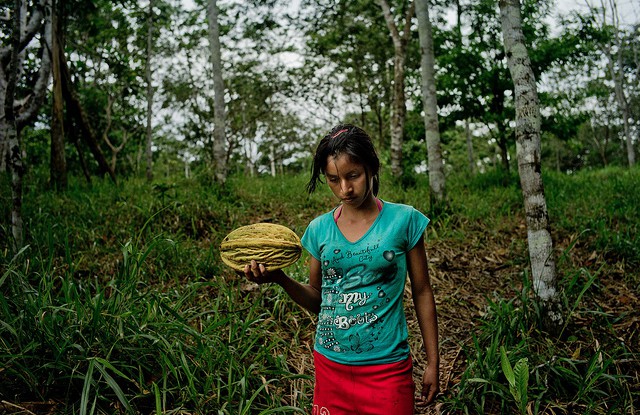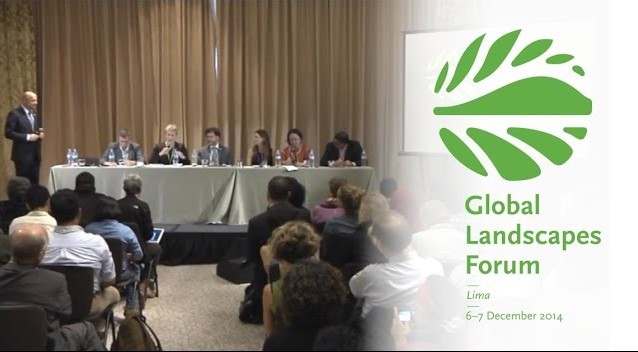
LIMA, Peru—Forests are an important link in the food chain, especially for women and children and others at high risk of hunger and malnutrition, early results from ongoing research shows.
But land rights are a crucial enabling factor in the food security of forest people, experts say.
“Forests and trees alone will not achieve global food security, but they can play a major role,” Terry Sunderland, principal scientist at the Center for International Forestry Research (CIFOR), said at a panel discussion session at the 2014 Global Landscapes Forum in Lima.
The forum was organized by CIFOR, the United Nations Environment Program (UNEP) and the UN Food and Agriculture Organization (FAO), on the sidelines of the annual UN climate change conference. It drew more than 1,700 people from 90 countries, including country climate negotiators, ministers, CEOs, indigenous leaders, civil society leaders and researchers.
Forested landscapes provide food, fuel, fodder and products that families can barter or sell for cash.
“Managing those multi-functional landscapes in a way that combines food production, biodiversity conservation and maintenance of ecosystem services helps families achieve food and nutritional security,” Sunderland said.
The study, which examines connections among forests, nutrition and food security, is being conducted by the Global Forest Expert Panel on Forests and Food Security, jointly sponsored by CIFOR and the International Union of Forest Research Organizations (IUFRO).
More than 1 billion people rely on forest products for food or income, and as much as 20 percent of rural people’s income comes from the environment, Sunderland said. Rural people in the tropics have a long tradition of managing their forests or partly forested landscapes, and 40 percent of the world’s food production comes from such smallholder agricultural systems, he said.
A comparison of nutrition data and tree-cover maps in 21 countries in Africa found that the greater the tree cover, the more diverse the diet—up to a point, Sunderland said.
A study of 93,000 children found that fruit and vegetable consumption increased with tree cover, peaked when forests covered about 45 percent of the landscape, and then decreased.
Although forests also shelter game animals, there was no statistically significant relationship between tree cover and game consumption, he said.
The findings indicate that forested landscapes are more adaptable, resilient and diverse than monocrops, and that they provide a variety of services important to nutrition and, therefore, human health, Sunderland said.
But the benefits of the forest food supply reach beyond those who live in the forest.
LAND TENURE A FOOD SECURITY ISSUE
On a spectrum that ranges from forest dwellers to urban denizens, there are a many different kinds of landscapes that combine trees and agriculture in different proportions, said Henry Neufeldt of the World Agroforestry Centre (ICRAF).
“If we only focus on forest dwellers, we’ll miss out on an entire area of food production from trees and agricultural systems that include trees,” Neufeldt said.
It is important for smallholders to have legal rights to the land and to those trees, he said.
Because ensuring access to forests is important, land tenure is not just a legal issue, but is also related to nutrition and food security, said Susan Braatz, senior forestry officer at the FAO.
Policies can encourage forest conservation by giving people access to resources, Braatz said. She cited a case in Niger, where people planted 5 million hectares of trees after government policy changed to give them rights to the trees on their lands.
Governments can also change policies that create perverse incentives, such as those that prohibit small farmers from cutting and selling trees from managed agroforestry systems and farms. If they cannot benefit from those resources, they have no incentive to manage them well, she said.
Braatz highlighted the need to include women in decision-making and to ensure that information from the panel’s study reaches policy makers.
The expert panel on forests and food security plans to produce a report based on its research, to help government officials and others design science-based policies and projects related to forests, nutrition and food security.
For more information about this topic, please contact Terry Sunderland at t.sunderland@cgiar.org.
We want you to share Forests News content, which is licensed under Creative Commons Attribution-NonCommercial-ShareAlike 4.0 International (CC BY-NC-SA 4.0). This means you are free to redistribute our material for non-commercial purposes. All we ask is that you give Forests News appropriate credit and link to the original Forests News content, indicate if changes were made, and distribute your contributions under the same Creative Commons license. You must notify Forests News if you repost, reprint or reuse our materials by contacting forestsnews@cifor-icraf.org.
